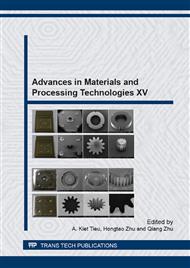[1]
C.M. Gigel, United States Patent 0160710. (2006)
Google Scholar
[2]
A. Pettersson, K. Elisabet and I. Minami, Additives for environmentally adapted lubricants-friction and wear protection, Tribology Online, 3 (2008) 163-167.
DOI: 10.2474/trol.3.163
Google Scholar
[3]
A. Pettersson, K. Elisabet and I. Minami, Additives for environmentally adapted lubricants-tribo film formation, Tribology Online, 3 (2008) 168-172.
DOI: 10.2474/trol.3.168
Google Scholar
[4]
E. Kettler, C.B. Muller, R. Klemp, M. Hloucha, T. Doring, W. von Robiski and W. Ritchering, Polymer-stabilized emulsions: influence of emulsion compositions on rheological properties and droplet size, Progress in Colloid and Polymer Science, 134 (2008) 90-100.
DOI: 10.1007/2882_2008_074
Google Scholar
[5]
C. Zhang, J. Liu, C. Zhang and S. Liu, Friction reducing and anti-wear property of metallic friction pairs under lubrication of aqueous solutions with polyether added, Wear, http://dx.doi.org/10.1016/ j.wear.2012.06.005 (2012).
DOI: 10.1016/j.wear.2012.06.005
Google Scholar
[6]
J.T. Laemmle, United States Patent 4452711. (1984)
Google Scholar
[7]
J.T. Laemmle, United States Patent 4452712. (1984)
Google Scholar
[8]
Z. Zhou and B. Chu, Phase Behavior and Association Properties of Poly(oxipropylene)-Poly(oxyethylene)-Poly(oxypropilene) Triblock Copolymer in Aqueous Solution, Macromolecules, 27 (1984) 2025-2033.
DOI: 10.1021/ma00086a008
Google Scholar
[9]
M.A. James-Smith, D. Shekhawat, S. Cheung, B.M. Moudgil and S.O. Shah , Role of ethylene oxide and propylene oxide groups of pluronics in binding of fatty acid to pluronics in microemulsions, Journal of Surfactants and Detergents, 11 (2008) 237-242.
DOI: 10.1007/s11743-008-1077-3
Google Scholar
[10]
T. Patel, P. Bahadur and J. Mata, The clouding behavior of PEO–PPO based triblock copolymers in aqueous ionic surfactant solutions: A new approach for cloud point measurements, Journal of Colloid and Interface Science, 345 (2010) 346-350.
DOI: 10.1016/j.jcis.2010.01.079
Google Scholar
[11]
Z. Yang and R. Sharma, Dynamics of PEO-PPO-PEO and PPO-PEO-PPO triblock copolymers at the air/water interface upon thermal stimulation, Langmuir, 17 (2001) 6254-6261.
DOI: 10.1021/la010468v
Google Scholar
[12]
A. Hambardzumyan, V. Agui-Bghin, M. Daoud and R. Douillard, â-Casein and symmetrical triblock copolymer (PEO-PPO-PEO and PPO-PEO-PPO) surface properties at the air-water interface, Langmuir, 20 (2004) 756-763.
DOI: 10.1021/la030294c
Google Scholar
[13]
S. Lee and N.D. Spencer, Aqueous lubrication of polymers: Influence of surface modification, Tribology International, 38 (2005) 922-930.
DOI: 10.1016/j.triboint.2005.07.017
Google Scholar
[14]
J.A. Baker and J.C. Berg, Investigation of the adsorption configuration of poly(ethylene oxide) and its copolymers with poly(propylene oxide) on model polystyrene latex dispersions, Langmuir, 4 (1988) 1055-1061.
DOI: 10.1021/la00082a042
Google Scholar
[15]
Y. Li, H. Liu, J. Song, O.J. Rojas and J.P. Hinestroza, Adsorption and Association of a Symmetric PEO-PPO-PEO Triblock Copolymer on Polypropylene, Polyethylene, and Cellulose Surfaces, ACS Appl. Mater. Interfaces, 3 (2011) 2349-2357.
DOI: 10.1021/am200264r
Google Scholar
[16]
Y. Li, O.J. Rojas and J.P. Hinestroza, Boundary lubrication of PEO-PPO-PEO triblock copolymer physisorbed on polypropylene, polyethylene, and cellulose surfaces, Ind. Eng. Chem. Res., 51 (2012) 2931-2940.
DOI: 10.1021/ie202292r
Google Scholar
[17]
X. Liu, D. Wu, S.T. Cohen, J. Genzer, T.W. Theyson, and O.J. Rojas,Adsorption of a Nonionic Symmetric Triblock Copolymer on Surfaces with Different Hydrophobicity', Langmuir, 26 (2010) 9565-9574.
DOI: 10.1021/la100156a
Google Scholar
[18]
B. Lin, A.K. Tieu, H. Zhu, B. Kosasih, O. Novareza and G. Triani, Tribological performance of aqueous copolymer lubricant in loaded contact with Si and coated Ti film, Wear, 302 (2013) 1010-1016.
DOI: 10.1016/j.wear.2013.01.068
Google Scholar
[19]
B. Kosasih, O. Novareza, A.K. Tieu and H. Zhu, Friction and anti-wear property of aqueous tri-block copolymer solutions in metal forming, Int. J. Surface Science and Engineering, X (xxxx) 000–000.
DOI: 10.1504/ijsurfse.2014.060480
Google Scholar
[20]
R. Sharma and P. Bahadur, Effect of Different Additives on the Cloud Point of a Polyethylene Oxide-Polypropylene Oxide-Polyethylene Oxide Block Copolymer in Aqueous Solution, Journal of Surfactants and Detergents, 5 (2002), 263-268.
DOI: 10.1007/s11743-002-0226-9
Google Scholar
[21]
N. Canter, Special Report: Trends in extreme pressure additives, Tribology & Lubrication Technology (2007).
Google Scholar
[22]
ASTM G 99-95a, Standard Test Method for Wear Testing with a Pin-on-Disk Apparatus (2000).
Google Scholar
[23]
ASTM G 133-02, Standard Test Method for Linearly Reciprocating Ball on Flat Sliding Wear (2002).
DOI: 10.1520/g0133-02
Google Scholar
[24]
P. Alexandridis, T.A. Hatton, Review Poly(ethylene oxide)-poly(propylene oxide)-poly(ethylene oxide) block copolymer surfactants in aqueous solutions and at interfaces: thermodynamics, structure, dynamics, and modeling, Colloids and Surfaces A 96 (1995), 1-46.
DOI: 10.1016/0927-7757(94)03028-x
Google Scholar
[25]
C.S. Saba and N.H. Forster, Reactions of aromatic phosphate esters with metals and their oxides, Tribology Letters, 12 (2002) 135-146.
Google Scholar
[26]
N.P. Suh, An overview of the delamination theory of wear, Wear, 14 (1977) 1-16.
Google Scholar
[27]
D.A. Rigney, Comments on the sliding wear of metals, Tribology International, 30 (1997) 361–367.
DOI: 10.1016/s0301-679x(96)00065-5
Google Scholar
[28]
I. Iliuc and M. Jokl, A comparative investigation of the sliding wear mechanism in lubricated steel-on-steel and diamond-on-steel friction pairs, Wear, 176 (1994) 73-79.
DOI: 10.1016/0043-1648(94)90199-6
Google Scholar
[29]
Q. Lin, E.E. Meyer, M. Tadmor, J.N. Israelachvili and T.L. Kuhl, Measurement of the long- and short-range hydrophobic attraction between surfactant-coated surfaces, Langmuir, 21 (2005) 251-255.
DOI: 10.1021/la048317q
Google Scholar


